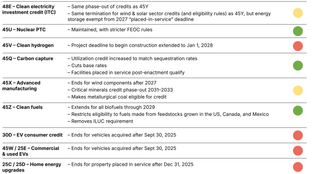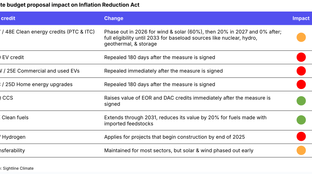
🌎 Bright spots and sunsets in the OBBB #253
One Big Beautiful Bill ushers in new (and old) energy agenda
Google introduces a new rate structure to bring clean firm power online for data centers.
Happy Monday!
Hope you’re staying cool in this heat wave. Google is turning up a different kind of heat by introducing a Clean Transition Tariff, a new type of energy rate structure in Nevada that would allow corporates to pay extra for clean firm power — a potential game changer for getting next-gen technologies like advanced geothermal, nuclear, and LDES on the grid.
In other news, Europe’s new tariffs for Chinese EVs; Musk’s big payday; and Solugen gets the “Tesla loan.”
In deals, a $5bn emerging markets climate fund; $382m for liquid air energy storage; and $136m for EV charging.
Thanks for reading!
Not a subscriber yet?
📩 Submit deals and announcements for the newsletter at [email protected].
💼 Find or share roles on our job board here.
First came FiTs, then RECs, then PPAs, and now – the CTT.
Now that the AI race is in full swing, the rally for clean, firm power has begun. Tech companies like Google, who have long been pushing the envelope on net zero, are now taking “power” back into their own hands with a new power procurement structure, the Clean Transition Tariff (CTT).
Last week, Google introduced this first-of-its-kind model, the CTT, to bring new clean, firm power online, where it would otherwise be too expensive for a utility to add to its energy mix. In other words, the CTT lets corporate giants with deep pockets opt to pay a higher rate for much-needed clean, firm power without putting the burden on the everyday ratepayer.
So how does it work?
Google’s CTT model, proposed as part of its partnership with the utility NV Energy (NVE), aims to bring geothermal developer Fervo Energy’s 115 MW of enhanced geothermal power onto the grid to power two of its Nevada data centers. But it’s not just for Google and Fervo:
Why this matters
Special thanks to Briana Kobor and Gabe Malek for contributing to this piece.
⚡ FLO, a Québec, Canada-based EV charging network operator, raised $136m in Growth funding from Export Development Canada, Business Development Bank of Canada, Caisse de Depot et Placement du Quebec, Energy Impact Partners, Investissement Quebec, and MBK Partners.
⚡ Battery Smart, a New Delhi, India-based battery swapping network platform, raised $65m in Series B funding from LeapFrog Investments, Blume Ventures, British International Investment, Ecosystem Integrity Fund, MUFG Bank, and Panasonic.
🔋 Echion Technologies, a Cambridge, England-based fast charging battery anode materials developer, raised $31m in Series B funding from BGF, CBMM, Cambridge Enterprise, and Volta Energy Technologies.
⚡ Gorilla, an Antwerpen, Belgium-based utility data management platform, raised $27m in Series B funding from Headline, Beringea, and PMV.
🏠 Parity, a Toronto, Canada-based HVAC operations management platform, raised $19m in Series B funding from Idealist Capital.
☀️ Swift Solar, a San Carlos, CA-based solar perovskite cell maker, raised $27m in Series A funding from Eni Next, Fontinalis Partners, BlueScopeX, Climate Capital, Good Growth Capital, HL Ventures, Stanford University, and Toba Capital.
⚡ ElectronX, a Chicago, IL-based electricity market exchange, raised $15m in Seed funding from Amplo, BoxGroup, DCVC, Innovation Endeavors, and Lightning Capital.
🔋 UNIGRID Battery, a San Diego, CA-based sodium-ion battery maker, raised $12m in Series A funding from Foothill Ventures, Ritz Venture Capital, Transition Venture Capital, and Union Square Ventures.
⚒️ Aepnus Technology, an Oakland, CA-based electrified chemicals manufacturer, raised $8m in Seed funding from Clean Energy Ventures, Impact Science Ventures, Lowercarbon Capital, MUUS Climate Partners, Nextfab, and Voyager Ventures.
🏠 Rendesco, a Royal Leamington Spa, England-based ground-source heat pumps maker, raised $7.7m in Seed funding from Aviva Ventures, Clean Growth Fund, Copley Point Capital, and Eurazeo.
🐄 Beta Bugs, an Edinburgh, Scotland-based maker of insect protein for animal feed, raised $2.2m Pre-Seed funding from the TRICAPITAL Syndicate LLP, SIS Ventures, Scottish Enterprise, Beeches Group, Climate.vc, and InnovateUK.
⚡ Mirico, a Didcot, England-based maker of laser-based methane gas sensing tools, raised $2m in Seed funding from New Climate Ventures and Shell Ventures.
🚗 Torev Motors, a Washington D.C.-based axial flux electric motors maker, raised Pre-Seed funding from BetterWay, Climate Avengers, EcoSphere Ventures, and Intbox Ventures.
🔋 Highview Power, a London, England-based liquid air energy storage developer, raised $382m in Debt funding from Centrica, Goldman Sachs, KIRKBI, Mosaic, Rio Tinto, and UK Infrastructure Bank.
🧪 Solugen, a Houston, TX-based bio-based chemicals developer, secured a $214m loan guarantee from the U.S. Department of Energy (DOE) Loan Programs Office (LPO).
⚡ Zapmap, a Bristol, England-based electric vehicle network mapping platform, raised $2.2m in Convertible note funding from Good Energy.
Brookfield Asset Management, a Toronto, Canada-based investment firm, announced the launch of a $5bn emerging markets climate fund with a $1bn anchor commitment from ALTÉRRA.
Can’t get enough deals? See full listings and deal analytics on Sightline Climate
It’s tariff season! The European Union announced additional tariffs of up to 38% on Chinese EVs, just a week after US president Biden announced tariffs of 100%. The decision reflects the growing concern in the EU and US about the influx of subsidized Chinese green tech products into global markets, as Chinese EVs made up roughly a fifth of European EV sales last year.
Meanwhile, Tesla CEO Elon Musk got his money and his move approved, as Tesla shareholders voted to reinstate Musk’s $45bn pay package. While initially rejected by a Delaware judge, where the company is located (until it soon moves to Texas), the all-stock compensation remains entangled in legal proceedings and is unlikely to be resolved soon.
Biochemical maker Solugen received a conditional commitment for a $214m loan from the DOE to construct a new Bioforge in Minnesota — the single largest US government investment in bioindustrial manufacturing to date. This FOAK commercial facility will produce eco-friendly chemicals from corn sugar for concrete production, industrial and wastewater treatments, and household detergents.
Formerly well-renowned companies SCiFi Foods and Running Tide ceased operations this week. Reflecting broader challenges in the cultivated meat industry, SCiFi Foods faced difficulties fundraising despite having previously raised $40m from investors. Meanwhile, pioneering carbon removal startup, Running Tide, grappled with a contracting voluntary carbon market despite having raised $50m.
In nuclear news, Terrapower broke ground on the first US SMR facility in recent history, which will house a sodium-cooled reactor, although it’s still waiting on a permit via the Nuclear Regulatory Commission. Plus, the US DoD posted an RFP for microreactors through the Advanced Nuclear Power for Installations (ANPI) program, aiming to deploy the microreactors on-site by 2030.
Meanwhile, across the pond, the UK Labour Party released a manifesto pledging to decarbonize the electricity grid by 2030. That includes carbon capture and storage (CCS), hydrogen and marine energy, long-term energy storage, and new nuclear power.
A new IEA report predicts a slowdown in global oil demand growth in the medium-term. It notes that amid a surging supply, oil markets are poised for a major surplus in the next decade, leading to unprecedented spare capacity levels rivaled only by those resulting from the height of COVID-19-related shutdowns.
Two emerging climate technologies join forces as Oxy and TAE sign a deal for fusion-powered carbon removal in Oxy’s DAC facility.
COP preview just dropped, as Bonn climate talks wrap up.
RMI report presents climate tech charts galore.
John Oliver dives into deep sea mining.
How deep is your geo knowledge? Try FORGE’s geothermal crossword.
Goats, the Office of Coal, and what Jennifer Wilcox is up to next.
When it was too hot to work, insurance helped 46,000 Indian women get paid.
Hot dog eating contest controversy as all-timer Joey Chestnut pulls out because he can’t promote alt-meat.
US government says it helped EV buyers save more than $1bn from point-of-sale rebates.
📅 EM Power Conference: Register to attend the EM-Power Europe Conference from June 18-19th and engage with experts focused on modernizing and digitalizing the power grid into a flexible smart grid.
📅 Battery Show: Register to attend the Battery Show Europe from June 18-20th to connect with industry leaders, top battery manufacturers, and buyers and explore the latest advancements in battery and electric vehicle technology.
📅 London Climate Action Week: London’s own climate week will be June 22-30th with 200+ in-person and virtual events and 45,000+ attendees. If you’re in town, shoot us a note!
📅 Pickleball for the Planet: Register to join Pickleball for the Planet on July 1st for a night of pickleball fun in support of young climate leaders.
💡 Bezos Earth Fund: Apply to participate in the Bezos Earth Fund AI for Climate and Nature Grand Challenge by July 30th to receive up to $50,000 in funding and mentorship for your climate tech startup.
Product Designer, Research Lead, Data Scientist @Sightline Climate
Climate Technology Investor @Vectors Capital
Data Analyst; Product Manager @Ohm Analytics
Head of Commercialization; Marketing and Communications Lead @Thalo Labs
Backend Software Engineer; Energy Systems Engineer @Sesame Sustainability
Program Manager II, Net Zero Content @Google
Analyst, Structured Finance (DSP) @EDF Renewables
Head of Strategy @Dioxycle
Business Development Executive (Buy-Side); Enterprise Marketing Associate @Reunion
📩 Feel free to send us deals, announcements, or anything else at [email protected]. Have a great week ahead!

One Big Beautiful Bill ushers in new (and old) energy agenda

Climate, capital, and carrots in London's new playbook

US plays popcorn politics with biofuels and beyond